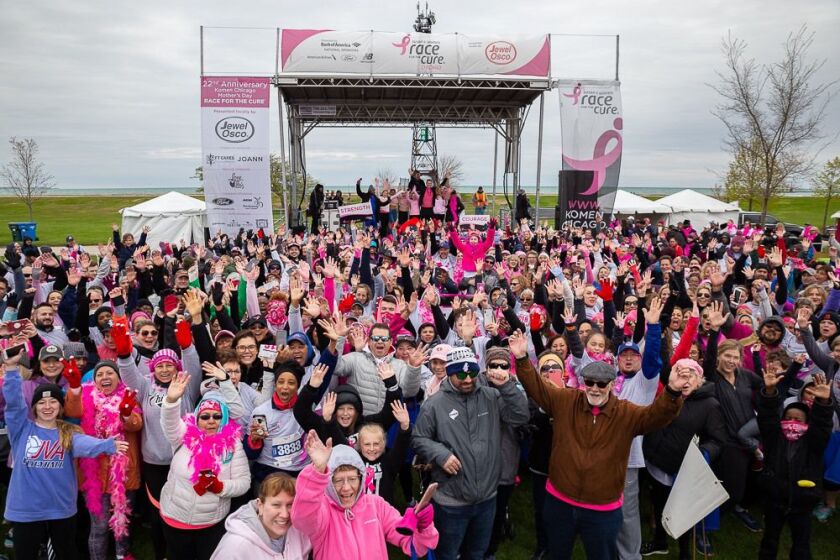On a typical weekend morning from early spring to late fall, Chicago’s lakefront normally hosts a never-ending array of charity walks and runs.
There’s the Walk for This and the Race for That, each dedicated to its own worthy cause, all sharing the common goals of fundraising and community building.
You probably know the drill. Participants, who are often survivors of the particular illness being recognized, join together with family and friends, then don commemorative T-shirts and race bibs to amble, jog or sprint in mass through the parks as giant speakers blast rock music.
But not in 2020.
In the year of the pandemic, races and race-goers are gone, posing a special challenge to the charities that rely on them.
In their place, the same nonprofits are organizing “virtual walks” and “virtual runs.” And if that somehow strikes you as hardly the same, just remember it’s all for a good cause.
In place of mass gatherings, participants are being invited to “race where you are” and follow along on mobile apps that will chart their progress and share photos, live video feeds and messages of encouragement.
Fundraising remains a centerpiece, but organizations are scrambling to recreate the bond that comes with uniting in one place with friends and strangers to fight an illness that might have claimed or endangered the life of a loved one.
“The idea is to profusely thank everyone for hanging in there,” said Leslie Crouch, director of events for the American Brain Tumor Association, which originally was scheduled to hold its Breakthrough for Brain Tumors BT5K in May.
Crouch said Chicago’s BT5K race, which usually draws 4,500 to 6,000 entrants, will start with a kickoff event Sept. 26 and wrap up with a closing celebration Oct. 4, giving runners more than a week to run their race at a time and place of their own choosing. One entrant is planning to use a standup paddleboard, she said.
The Susan G. Komen Race for the Cure, benefiting breast cancer research and usually held on Mother’s Day at Montrose Harbor, will be conducted virtually on Oct. 24.
The Heart Walk, sponsored by the American Heart Association, is scheduled Sept. 18 and 19. It normally starts from Soldier Field, but this year race organizers will gather there to broadcast a kickoff event featuring DJ Mars.
Those are just a few of the big ones, but others are following suit.
Organizers say they are hopeful virtual events will adequately fill the void — and produce some side benefits as well — until the world can return to a more normal footing, fingers crossed, in 2021.
“Obviously, it’s going to be different, but I think people are yearning for that sense of connection,” said Julie Jacobson, director of donor partnerships for Komen Chicago.
Putting a positive spin on a difficult situation is to be expected, but there do seem to be some advantages to the virtual formats.
Race participants are no long locked into a particular time and place, meaning out-of-town friends and relatives can show their support without making the trip to Chicago. It’s also helpful to those with work or other time conflicts.
As a result, “We were able to connect with more people than we ever have,” said Stacia Hart, executive director of the Rolfe Pancreatic Cancer Foundation, which held a virtual race July 18 via social media in place of its annual DASH for Detection.
Plus, there’s a significant savings from not holding a physical event: no permit fees to the Chicago Park District, no cost for portable toilets, tents, refreshments, cleanup, etc.
Those expenses usually tally about 10 percent of what the Heart Walk raises, said Lisa Hinton, executive director of the American Heart Association Metro Chicago. She expects expenses this year to drop to less than 1 percent.
The advantages are such that most organizers say they will plan for a hybrid event in the future that offers a virtual participation option for those who choose not to attend the actual race.
But nobody’s kidding themselves. Something gets lost in the switch.
Part of that is money. The American Brain Tumor Association, which originally expected to raise $837,000 from its Chicago event, has dropped its goal to $500,000.
The other loss is more difficult to quantify.
“What I’m going to miss most is that spirit of camaraderie and seeing you’re really not alone,” said the Race for the Cure’s Jacobson. “This event is just so important for so many people.”
For the couch potatoes, a virtual race might seem the perfect excuse to skip the physical activity and send in the money, but the folks at the Heart Walk have higher expectations.
“We want them to get out and move,” Hinton said.






